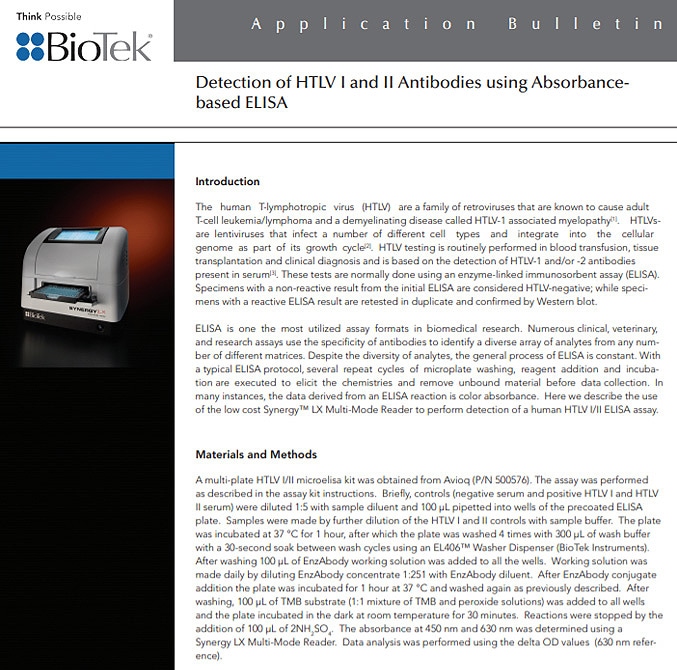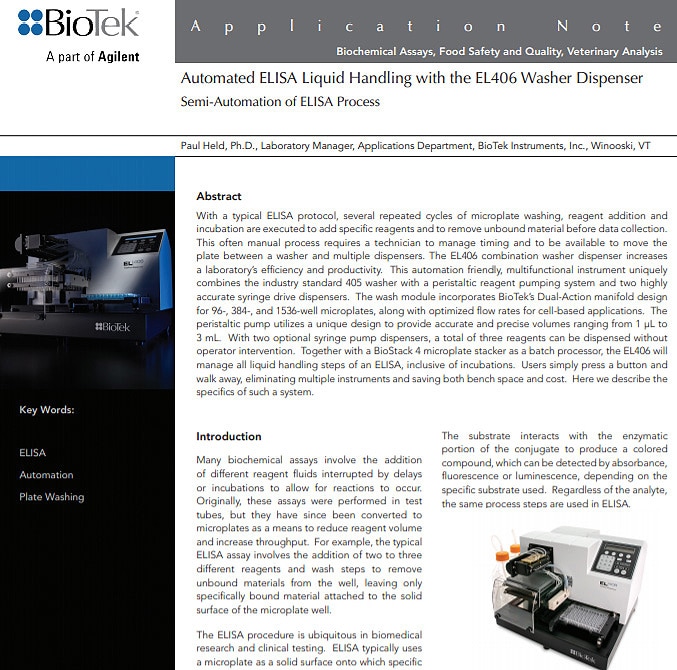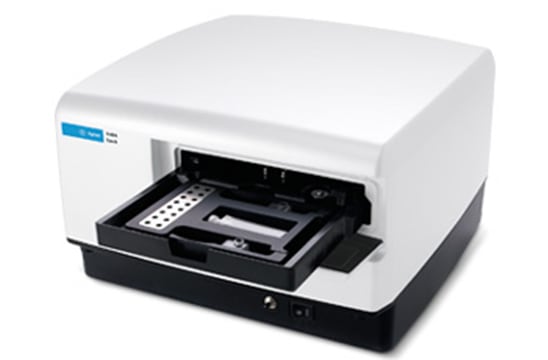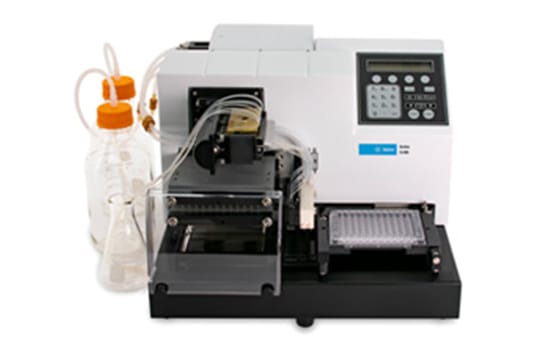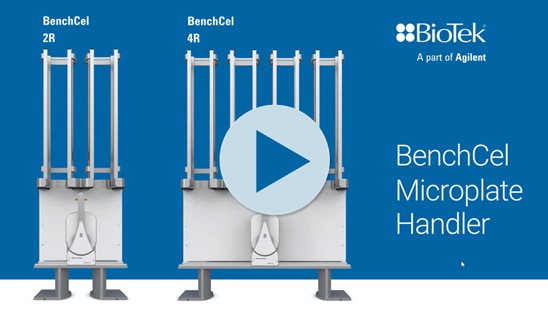ELISA
November 2020
The enzyme-linked immunosorbent assay (ELISA) procedure is ubiquitous in biomedical research and clinical testing. ELISA, first described by Engvall and Perlmann in 1971, is an antibody-based reaction that allows the detection and quantitation of numerous analytes with the same basic assay process. ELISA typically uses a microplate as a solid surface on to which specific antibodies are bound allowing the capture and analysis of a seemingly infinite number of analytes. It does so by a series of incubations, reagent additions and wash-steps. During incubations specific molecules are bound to the solid substrate by interactions with the previously absorbed antibodies. Following the binding step, unbound material is removed by the washing step. After the unbound material has been removed the next reagent, usually a conjugate, is added and allowed to specifically interact. The conjugate is a chimeric molecule containing a specific antibody and an enzyme protein covalently linked. Again unbound material is removed and the next reagent, substrate added afterward. The substrate interacts with the enzymatic portion of the conjugate to produce a colored compound, which can be detected by absorbance, fluorescence or luminescence depending on the specific substrate used. Regardless of the analyte, the same process steps are used in ELISA.
Featured Applications
Product Spotlight
Epoch 2 Microplate Spectrophotometer
Epoch 2 is a monochromator-based microplate spectrophotometer for 6- to 384-well microplates, cuvettes and 2 µL measurements from 200 – 999 nm. It has an optional touchscreen interface and onboard software for endpoint, kinetics and spectral scanning applications. Incubation, shaking and robot compatibility are standard.
EL406 Washer Dispenser
The EL406 Combination Washer Dispenser offers fast, full plate washing along with three reagent dispensers in one, compact instrument. Its multiple capabilities include washing and dispensing for standard assays, plus biomagnetic separation and vacuum filtration protocols. The Dual-Action manifold optimizes washing for loosely adherent cell monolayers, while the patented Ultrasonic Advantage helps prevent blockages in the manifold tubes before washing, to reduce assay failure.
Tek Tips
ELISA Setup and Optimization
While a number of ELISAs currently exist today, when designing a new assay a number of criteria should be considered. These include, but are not limited to the following:
- Choice of microplate
- Coating procedure
- Optimization of assay components
Choice of microplate
The first choice for optimizing ELISA optimization is selection of a microplate. The attachment of antigens or antibodies to the bottom of microplate wells, or coating, is based upon passive adsorption. Polystyrene, the most common material used in microplates for immunology-based applications, is hydrophobic in nature. Due to the fact that ELISAs require hydrophilic groups at the surface, ELISA plates are then treated to introduce a defined number of hydrophilic groups within each well. The number can vary, and most plate manufacturers create a medium and high binding option to choose from. Using a plate with the appropriate number of hydrophilic groups can dramatically effect binding of assay components and ultimately final results. This was proven in a study published by Greiner Bio-One where binding of IgG and Insulin was compared using high binding ELISA MICROLON® 600 and CELLSTAR® plates optimized for adherent tissue culture. The CELLSTAR plates are also treated to make the surface hydrophilic. However the number of polar groups is much higher than the high binding ELISA plate. OD450 values were ~2.5X higher for the IgG assay and >10X higher for the insulin assay when using the high binding ELISA plate compared to the tissue culture plate, respectively, confirming the importance of incorporating the correct microplate into the ELISA procedure1.
Coating procedure
In addition to microplate selection, coating procedure can also play a critical role, with regard to coating buffer and the manner in which the coating is performed. The pH of the buffer can present a structure that results in a higher degree of adsorptive binding of the target molecule to the wells of the chosen microplate. A commonly used buffer is 0.05 M Carbonate buffer, pH 9.6. However as previously described, other buffers that may adsorption are 10 mM PBS, pH 7.4 and acetate buffer, pH 5.52. It is also important to be aware that passive adsorption of the target molecule to the bottom of a physically modified microplate well may not be achievable due to the properties of the molecule itself, including size, number and localization of epitopes, and binding properties to the surface. Two alternative binding methods can be employed when this is the case. The first is to use streptavidin coated microplates. Here streptavidin acts as the solid surface to which biotinylated molecules can then be attached. The second is to use a microplate with wells containing a three-dimensional surface. This allows coupling of molecules via covalent binding using standard coating buffers.
Optimization of assay components
A final step in optimization of the assay itself is to empirically determine the proper concentration and incubation period for the remaining components. Commonly this is accomplished by creating a two-way, or checkerboard titration, where one component is titrated across the plate, and a second is titrated down the plate (Figure 1).
The combination of final concentrations yielding the greatest assay window can then be easily identified and incorporated into the final assay procedure.
References
- Greiner Bio-One, Insulin ELISA on high binding MICROLON® 600 and CELLSTAR® microplates, March 2011
- Raem A. M, Rauch P (2007) Immunoassays. Spektrum Akademischer Verlag, Elsevier GmbH, München.
ELISA Automated Wash Procedure and Optimization
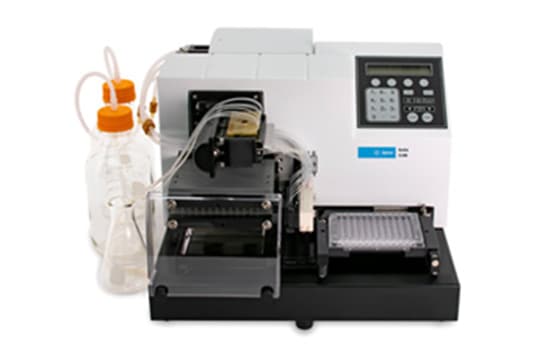
One of the critical elements of the ELISA procedure is the wash step. As mentioned previously, ELISA assays have been standardized through the use of microplates, allowing the use of instrumentation to automate the process steps of the assay. As such, plate washing can be performed using dedicated instrumentation to dispense and aspirate wash fluids. Below are several tips and suggestions in regards to using automated washers that can provide the best possible outcome for the ELISA assay.
- Washer configuration
- Pre-wash consideration
- Wash optimization and QC
Washer configuration
In order to obtain consistent intra-plate results, all of the aspiration tubes need to address the bottom of the microplate equally. If the microplate is not parallel or tilted relative to the aspiration tubes, the residual volume left behind will vary. With an increasing space between the microplate bottom and the aspiration tube opening, a greater fluid residual will remain after aspiration. BioTek Automated microplate washers are aligned with high precision to be parallel to the microplate carrier at the time of manufacture. In addition, the microplate carrier can be adjusted in using the onboard software utilities. It is always a good idea to periodically check that microplate carrier is parallel to the washer manifold and adjust it if needed. During setup, it is advisable to make sure that all connections are correct tight and the waste bottles tops are snug. Note that the tubing set for BioTek washers are color coded to make sure the supply and waste tubing is connected correctly.
Pre-wash considerations
BioTek washers have preloaded default parameters that will adequately perform the wash for most ELISA assays. Having said that, differences in plate geometries, assay subtleties and different buffer constituents necessitate that the washer parameters be optimized for the best washing performance. BioTek's automated washers have several different parameters that can be varied for both aspiration and dispense. For example, the location and height of the dispense tubes can be altered. Some washer manifolds have angled dispense tubes. By changing the dispense X-axis parameter, the dispense tube can be shifted toward one side of the well. Different plate heights can be accommodated by altering the Z-axis setting. Similar parameters are available for the aspiration tubes as well. While, the default position is the center of the well, several plate types require aspiration from the well edge for more effective aspiration. Likewise, differences in the physical height of the microplate bottom require a different aspiration Z-height setting. To minimize the residual the aspiration tube need to be as close to the bottom as possible, without actually touching the well. The aspiration rate can also be changed from very gentle to aggressive, depending on the nature of the assay.
Once the wash parameters have been optimized the two critical items that need to be addressed. Firstly and most importantly, it is necessary that the wash programing follow the assay kit instructions. Make sure that the correct number of wash cycles, dispense volume, soak time and shaking (if required) are correctly programmed. These wash parameters for assay kits directions have been optimized by the kit manufacturers. Immediately before the run it is critical that the washer supply and waste bottles have been attached correctly. While the supply container is not pressurized, the waste bottle is under vacuum and the top needs to be seated correctly and the tubing connected. Note that the fluid flow sensors would alert the user, but a little bit of care can save time. Lastly, the washer needs to be primed with the appropriate buffer. This step removes residual fluids and air and replaces them with the appropriate buffer fluid. Failure to do so will result in either the no wash buffer or wrong solution being dispensed. BioTek's quick prime feature has been developed sufficiently prime the washer system.
Wash optimization and QC
There are several thing to watch for during the actual wash step. This is particularly important with the first plate of a run, as any issues are likely to be propagated though all of the plates. Watch to make sure the well is completely filled to ensure that all of the unbound material is removed. As a rule, the programmed dispense-volume for the wash should greater than any of the reagents additions. The fill volume for most assays should completely fill the well and form a slight dome above the top of the well without spilling into adjacent wells. BioTek's automated washers provide simultaneous aspiration during the fluid dispense as a means to prevent this from occurring. Count the number of wash cycles as a self-check on the assay programming. Provided that the first plate looks satisfactory, it's likely the remainder of the plates to be processed will be OK as well. In addition to the visual observation, BioTek automated washers have several built in sensors to warn the user and stop the wash process if the wash buffer runs out or if the waste bottle completely fills.
Once the plate wash is complete, it is important to note if the plate(s) are aspirated satisfactorily. Single wells with excess residual fluid are usually indicative of some sort of clog. While rare, clogs can occur, particularly if the assay matrix is blood plasma. All of the wells being filled is indicative of some sort of programming error or a poor vacuum seal with the waste bottles. The small residual ( < 10 µL), which is normal, can be removed by blotting on a paper towel if desired. It is important to add the next reagent in a timely fashion. While you want all of the fluid from the wash step to be aspirated, it is important that the well not completely dry out. Note that the BioTek EL406 has both washer and dispenser capabilities and can accomplish the reagent addition automatically.
Once the plate wash steps are finished it is important to flush all of the lines with deionized water. This will remove any residual salts or proteins from the fluid lines and help prevent clogging as the fluid on the end of the aspiration and dispense tubes dries. A sonicating bath is an option for some BioTek washer models. This feature allows the user to program a sonicating clean cycle either at the end of the run or during the run to clean the manifold tubing.
Summary
The ELISA process is an amazing format that can provide qualitative and quantitative information on an infinite number of analytes. With some easy optimization the standardized format of the microplate can be utilized to automate these assays--improving accuracy, throughput, and reproducibility.
References
- Engvall, E and P. Perlmann (1972). "Enzyme-linked immunosorbent assay, Elisa". The Journal of Immunology. 109 (1): 129–135. ISSN 0022-1767. PMID 4113792.
ELISA Resources
Application Notes
- Versatile, Cost-Effective Automation of Avian Influenza and Mycoplasma Gallispeticum-Synovaie ELISAs
- Automation of a Novel Cell-Based ELISA for Cell Signaling Pathway Analysis
- Concentration and Detection of Low Levels of Escherichia coli O157:H7, Listeria monocytogenes 4b, and Salmonella enterica Typhimurium in High Organic Load Lettuce Wash
- Using EL406 Combination Washer Dispenser to Semi-automate a Competitive ELISA for Melamine - Semi-Automated Melamine Quantitation
- Histamine Analysis in Wine Samples Using the Microplate Format
- AlphaLISA: Human Insulin Quantification Using Synergy 4 Hybrid Multi-Mode Microplate Reader
Technical Notes
Webinar
ELISA: Best Practices and Troubleshooting
Presenter: Dr. Paul Held - Applications Laboratory Manager, BioTek Instruments
Enzyme-linked immunosorbent assay (ELISA) is an antibody-based reaction that allows the detection and quantitation of numerous analytes with the same basic assay process. The reaction uses a solid surface, typically a microplate, to immobilize the analyte. Once immobilized, unwanted materials can be removed by washing and the remaining analyte quantitated. The assay technology uses antibodies in conjunction with enzyme-catalyzed amplification to provide high specificity and high sensitivity. Here we will describe the basic process steps of ELISA, best laboratory practices along with troubleshooting tips for common problems. In addition, some of the devices and instrumentation used with this assay technology will be described.
For Research Use Only. Not for use in diagnostic procedures.
